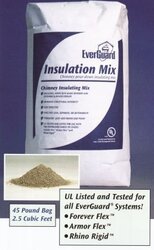stejus
Minister of Fire
Went and picked up some Roxul Safe n Sound this morning. I couldn't figure out how there were 12 3x15.5x47"inch peices of insulation in this bag. I open it and it expanded about twice the size! This stuff was so much easier to work with than fiberglass insulation.
I did this with the stove in place and it was not that bad. I cut sections into 4" strips. Just started stuffing them into the open damper area. I was able to get a 2 full bats of insulation up in the smoke shelf area. Then I cut a section to fit into place on each side of the liner. I then supported this with insulation hangers. These are made of steel so I didn't see any problems with this approach.
Still to warm to test so I'll have to wait until next week when temps fall into the 50's.
I did this with the stove in place and it was not that bad. I cut sections into 4" strips. Just started stuffing them into the open damper area. I was able to get a 2 full bats of insulation up in the smoke shelf area. Then I cut a section to fit into place on each side of the liner. I then supported this with insulation hangers. These are made of steel so I didn't see any problems with this approach.
Still to warm to test so I'll have to wait until next week when temps fall into the 50's.






